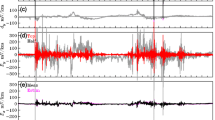Abstract
Synchronous observations of the electrotelluric field were performed on the lake ice and the coast. The ice-based vertical/horizontal field ratio at periods of a few seconds to a few minutes ranges from a few hundredths to a few thousandths, which is comparable to the noise level. The results of these observations favor a plane wave model. At the coastal station, the vertical and horizontal fields are similar, which is related to geoelectric heterogeneity of the medium. An electric tipper is used to control the behavior of heterogeneity in the spectral-time domain. Anomalous changes associated with earthquakes of K ≥ 12 are revealed from data of the tipper monitoring at epicentral distances of up to 300 km. A longitudinal MTS curve free from the effect of local geoelectric heterogeneities is obtained from ice-based data. Deep conducting layers are recognized as minimums in this curve.
Similar content being viewed by others
References
J. Benderitter, J. Burear, A. Dupis, and B. Geinlean, “Enregistrement de la Composante du Champ Tellurique, Normale a la Surface du Sol,” Compte Rendu Acad. Sci. 271(9), 498–500 (1970).
M. N. Berdichevsky, L. L. Vanyan, and V. I. Dmitriev, “Implications of Vertical Currents for Magnetotelluric Sounding,” Izv. Akad. Nauk SSSR, Fiz. Zemli, No. 5, 69–78 (1971).
M. M. Berdichevsky and M. S. Zhdanov, Interpretation of Earth’s Electric Field Anomalies (Moscow, Nedra, 1981) [in Russian].
I. K. Chantladze, Structural Studies of the Field of Geomagnetic Pulsations in Crystalline Massifs, Extended Abstract of Cand. Sci. Dissertation, Moscow, 1975.
D. N. Chetaev, V. A. Morgunov, I. K. Chantladze, et al., “Experimental Study of the Earth’s Natural Electromagnetic Field in a Range of 0.01–0.1 Hz,” in Abstracts of XI All-Union Conf. On Radiowave Propagation, part III (Kazan, 1975) [in Russian].
V. P. Gornostaev, “Magnetotelluric Studies of the Lake Baikal Basin,” Izv. Akad. Nauk SSSR, Fiz. Zemli, No. 6, 99–101 (1979).
F. W. Jones and L. P. Geldart, “Vertical Telluric Currents at Separated Locations,” Earth Planet. Sci. Lett. 3(2), 174–176 (1967).
N. V. Kransnogorskaya and V. P. Remizov, “Some Results of Measuring Electric Field Variations,” Dokl. Akad. Nauk SSSR, No. 2, 345–348 (1973).
I. C. Larsen, R. L. Mackie, A. Manzella, et al., “Robust Smooth Magnetotelluric Transfer Functions,” Geophys. J. Int. 124, 801–819 (1996).
W. D. Parkinson, “Direction of Rapid Geomagnetic Fluctuation,” Geophys. J. 2, 1–14 (1959).
E. S. Podlovilin, N. S. Gablin, P. F. Karyugin, and L. V. Korablev, “Vertical Telluric Profiling in Deep Boreholes,” in VI All-Union Workshop on Electromagnetic Sounding. Abstracts (Moscow, 1981) [in Russian].
U. Schmucker, Anomalies of Geomagnetic Variations in the South-Western United States (Univ. California, Berkley, 1970).
P. N. Tverskoi, Atmospheric Electricity (Gidrometizdat, Leningrad, 1949) [in Russian].
L. L. Vanyan, Electromagnetic Sounding (Nauchnyi Mir, Moscow, 1997) [in Russian].
L. L. Vanyan and A. I. Butkovskaya, Magnetotelluric Sounding of Layered Media (Nedra, Moscow, 1980) [in Russian].
P. A. Vinogradov, “Measuring the Vertical Component in Lake Baikal,” Izv. Akad. Nauk SSSR, Ser. Geofiz., No. 1, 83–86 (1959).
N. P. Vladimirov, V. A. An, V. S. Vishnev, A. G. Krasnobaeva, et al., “Vertical Components of Telluric Currents in the Tukeiskii Crystalline Massif,” Izv. Akad. Nauk SSSR, Fiz. Zemli, No. 3, 91–94 (1975a).
N. P. Vladimirov, V. A. An, A. G. Krasnobaeva, et al., “Vertical Telluric Currents in the Zhukeiskii Crystalline Massif,” Izv. Akad. Nauk SSSR, Fiz. Zemli, No. 3, 91–94 (1975b).
K. Vozoff, “The Magnetotelluric Method in the Exploration of Sedimentary Basins,” Geophysics 37, 98–141 (1972).
P. E. Wannamaker, J. A. Stodt, and L. Rijo, “A Stable Finite Element Solution for Two-Dimensional Magnetotelluric Modeling,” Geophys. J. R. Astron. Soc. 88, 277–296 (1987).
H. Wiese, Geomagnetische Tiefentelluric (Deutsche Akad. Wiss., Berlin, 1965).
Author information
Authors and Affiliations
Additional information
Original Russian Text © Yu.F. Moroz. T.A. Moroz. S.G. Buglova, 2008, published in Fizika Zemli, 2008, No. 3, pp. 73–83.
Rights and permissions
About this article
Cite this article
Moroz, Y.F., Moroz, T.A. & Buglova, S.G. Vertical and horizontal components of the lake Baikal electrotelluric field and their relation to the electric conductivity. Izv., Phys. Solid Earth 44, 239–248 (2008). https://doi.org/10.1134/S1069351308030075
Received:
Published:
Issue Date:
DOI: https://doi.org/10.1134/S1069351308030075




